|
|
|
Sort Order |
|
|
|
Items / Page
|
|
|
|
|
|
|
| Srl | Item |
| 1 |
ID:
171172
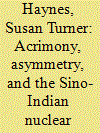

|
|
|
|
|
| Summary/Abstract |
While most contemporary analyses of South Asian nuclear dynamics acknowledge the presence of a strategic triangle between the region’s three nuclear players, the primary focus usually remains on the rivalry between India and Pakistan. Discussions of Sino-Indian relations remain limited. This is likely attributed to the stability in the two countries’ relations, yet it is worth asking why this stability exists and whether it is likely to continue in the future. Although China and India have an acrimonious relationship, their asymmetric nuclear capabilities and threat perceptions mitigate the danger of a traditional security dilemma. India may perceive China’s nuclear aggrandizement to be a security threat, but the same is not true of China, which has a vastly superior nuclear force and is largely shaping its nuclear-force structure in response to the threat it perceives from the United States. This dynamic makes a serious conventional or nuclear conflict highly unlikely.
|
|
|
|
|
|
|
|
|
|
|
|
|
|
|
|
| 2 |
ID:
156310
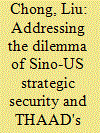

|
|
|
| 3 |
ID:
078777
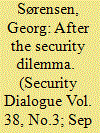

|
|
|
|
|
| Publication |
2007.
|
| Summary/Abstract |
The security dilemma - which raises the imminent risk of war between sovereign states - has always been considered the core issue of international relations. But, the security dilemma is in decline. Interstate war is no longer the supreme concern on the international security agenda. Instead, new dilemmas have emerged, in particular the insecurity dilemma and the associated value dilemma. The insecurity dilemma poses a looming risk of violent domestic conflict in weak states. The related value dilemma concerns the ambiguous content of core liberal values. Negative liberty is autonomy, self-determination and the ability to act unimpeded by others. The promotion of negative liberty calls for non-intervention. Positive liberty is removal of the obstacles that stand in liberty's way: oppression, poverty, ignorance and tyranny. The promotion of positive liberty calls for intervention. Emphasizing negative liberty creates grave problems; emphasizing positive liberty creates grave problems of a different kind. Compromises between intervention and non-intervention must always be troubled and uneasy, because they involve trade-offs between liberal values that are all desirable. There is no clear path to a more liberal world order
|
|
|
|
|
|
|
|
|
|
|
|
|
|
|
|
| 4 |
ID:
181643
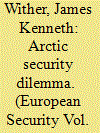

|
|
|
|
|
| Summary/Abstract |
After the Cold War, international relations in the Arctic were characterised by cooperation and diplomacy. However, since Russia's annexation of Crimea in 2014, largely peaceful relations in the High North have been endangered by growing military competition between Russia and Western Arctic powers. The lack of military to military dialogue between Russia and the West has exacerbated the situation. Consequently, an Arctic security dilemma has arisen, which threatens stability and increases the danger of unintended armed conflict resulting from accidents or misunderstandings. Security dilemmas are as old as international politics. They occur when states feel threatened by the expanding military capabilities of their neighbours even if there is no deliberate hostile intent. This article will examine the developing Arctic security dilemma and the chances of its mitigation. Two recent developments provide potential grounds for optimism. The new United States’ administration has pledged to return America to global engagement and multilateralism. In 2021, the Russian Federation is scheduled to become chair of the Arctic Council and the Arctic Coastguard Forum, the main intergovernmental institutions in the region. These events provide an opportunity to rebuild greater trust and confidence in relations between Russia and its Arctic neighbours and alleviate dangerous tensions.
|
|
|
|
|
|
|
|
|
|
|
|
|
|
|
|
| 5 |
ID:
131848
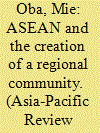

|
|
|
|
|
| Publication |
2014.
|
| Summary/Abstract |
After the ASEAN Concord II called for the building of an ASEAN Community in 2003, the creation of an ASEAN Community became a concrete part of the political agenda for the nations of Southeast Asia, and an ASEAN Community is scheduled to be created in 2015. However, it will all be for naught if the ASEAN Community that is established does not truly contribute to the stability and prosperity of the region. From this point of view, the article will attempt to evaluate the development of an ASEAN community concept and efforts to create it. To clarify the ideal of a true community, this article will take up Karl Deutsch's concept of "pluralistic security communities" and reconsider what a community requires. The article will state that the efforts to create an ASEAN Community should not be underestimated, and the blueprints for the creation of the ASEAN Community outline the formation of a true regional community. It will, however, conclude that in reality there exist factors within the ASEAN region that may shake the development of an ASEAN Community. It has to be said that the fostering of a sense of community at the level of ordinary people, as well as the creation of a community in which fundamental values and norms are shared, are distant propositions.
|
|
|
|
|
|
|
|
|
|
|
|
|
|
|
|
| 6 |
ID:
155090
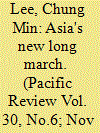

|
|
|
|
|
| Summary/Abstract |
This paper explores the probable causes and consequences of an Asian Paradox or the highly incongruous structure of Asia within the broader international system: at once the engine of global economic growth while at the same time, the repository of all of the world's outstanding security threats and challenges. Asia in the 21st century is going to be a key test bed of the commercial peace theory and whether the U.S.-China strategic rivalry will result in some type of a conflict. Attention is also paid to the potential consequences flowing from the end of Asia's Meiji era or when all of Asia's major powers and key middle powers have achieved or are well on their way of achieving what Japan accomplished by the late 1890s: a wealthy economy and a strong military. How an increasingly wealthy, technologically advanced, and a militarily sophisticated Asia decides to cope with numerous security dilemmas is Asia's new Long March including the extent to which the region's strategically consequential states are willing to preserve and to strengthen the prevailing liberal international order.
|
|
|
|
|
|
|
|
|
|
|
|
|
|
|
|
| 7 |
ID:
059910
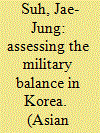

|
|
|
| 8 |
ID:
151647
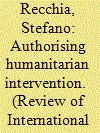

|
|
|
|
|
| Summary/Abstract |
Even scholars who support multilateralism in principle frequently question the value of securing approval from existing multilateral bodies for humanitarian intervention. The United Nations (UN) and regional organisations such as NATO, the argument goes, are far from democratic; furthermore, multilateralism is often a recipe for doing nothing; therefore, unauthorised intervention should be permissible in circumstances of ‘humanitarian necessity’. This article maintains that although today’s multilateral organisations and related procedures for authorising armed intervention may be suboptimal, they have significant output legitimacy. First, existing authorisation procedures reduce the risk of destabilising conflict spirals among powerful states. Second, they diminish the likelihood that humanitarianism will be used as a pretext. Third, they reduce epistemic problems concerning the identification of a just cause for intervention and thus the risk of accidental abuse. Fourth, they minimise the ‘moral hazard’ of humanitarian intervention. Finally, compliance with multilateral procedures is increasingly required for successful peacebuilding. This leads me to conclude that humanitarian warfare should always be authorised by the UN or regional multilateral organisations.
|
|
|
|
|
|
|
|
|
|
|
|
|
|
|
|
| 9 |
ID:
121860
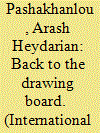

|
|
|
|
|
| Publication |
2013.
|
| Summary/Abstract |
Offensive realism argues that states committed to survive are nevertheless condemned to participate in a relentless struggle for power, and it holds the structure of the international system as the cause of this tragic outcome. This article subjects the logic behind this tragic worldview and the explanatory power of offensive realism to a careful and comprehensive scrutiny. This in-depth analysis of offensive realism amounts to a substantial critique of the theory as it fails to logically generate the brutish world it presupposes and is plagued by significant shortcomings in its explanatory model. These findings suggest that offensive realism cannot provide useful theoretical lenses for explaining and understanding international politics, even when it is assessed on its own terms.
|
|
|
|
|
|
|
|
|
|
|
|
|
|
|
|
| 10 |
ID:
134299
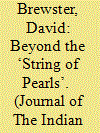

|
|
|
|
|
| Summary/Abstract |
The article will ask whether Sino-Indian strategic competition in the Indian Ocean should be properly understood through the lens of a security dilemma. It examines the strategic positions of India and China in the Indian Ocean and concludes that India has an overwhelming strategic advantage that China cannot realistically mitigate in the foreseeable future. This advantage precludes any real security dilemma arising between them. In fact, both China and India have good reasons to keep strategic competition under control while they each broaden their regional influence.
|
|
|
|
|
|
|
|
|
|
|
|
|
|
|
|
| 11 |
ID:
090145
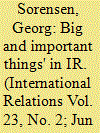

|
|
|
|
|
| Publication |
2009.
|
| Summary/Abstract |
Structural realism has important insights to offer regarding the current balance of power and its effects on world politics. But structural realism is less ready to analyze changes in statehood and their implications for international relations. States are not `like units' and anarchy does not always mean self-help. A richer concept of structure which includes economic power, political-military power, and international norms gives us a better take on the ways in which international forces affect domestic structures of states. In particular, they help us detect the weak states in the developing world, and the postmodern states in the OECD world. In weak states the classical security dilemma has been turned on its head: instead of domestic order and international threat there is domestic threat and international order. In postmodern states violent external threat has been dramatically reduced because these states make up a security community.
|
|
|
|
|
|
|
|
|
|
|
|
|
|
|
|
| 12 |
ID:
192077
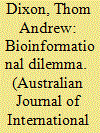

|
|
|
|
|
| Summary/Abstract |
Bioinformational diplomacy is a field of practice that emerges from the politics of biological information exchange during global public health emergencies. Cyberbiosecurity is a field of practice that emerges from the need to secure material at the interface of the digital and biological worlds from misuse and exploitation. Bioinformational diplomacy arises from the intersection of biologically-derived information becoming acutely valuable to national security actors, and the secrecy with which some valuable bioinformation is handled during global public health emergencies. This article analyses bioinformational diplomacy in relation to cyberbiosecurity and shows that both fields of practice are anchored by the concept of bioinformational secrecy. This paper explores the cooperative exchange and competitive exfiltration of bioinformation using the acute phase of the COVID-19 pandemic as a case study. During the COVID-19 pandemic, states sought to protect and covertly acquire certain types of bioinformation. This highlighted a potentially destabilising security dilemma that requires ongoing management via the practice of bioinformational diplomacy.
|
|
|
|
|
|
|
|
|
|
|
|
|
|
|
|
| 13 |
ID:
145529
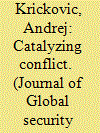

|
|
|
|
|
| Summary/Abstract |
Realists are accustomed to thinking about security competition between states in terms of the security dilemma: each state's efforts to improve its security can be taken as a threat by others, sparking competition that destabilizes the system and increases the likelihood of conflict. By focusing almost exclusively on external threat dynamics, however, common thinking about the security dilemma misses how domestic vulnerabilities can also be a catalyst for security competition. This is particularly the case in “weak” states that lack internal legitimacy. Weak developing states see intervention (whether perceived or real) targeted at their domestic vulnerabilities as an existential threat to political survival. When the targeted state responds to minimize or negate the threat, its response may be perceived as a threat, warranting a counter response. Particularly, when a targeted state possesses significant national power—as in the cases of China and Russia—a security competition is born. This article develops the logic behind this modified version of the security dilemma focused on internal vulnerabilities. Managing these internal fears will be of critical importance if we are to avoid the reemergence of security competition between great powers in the future.
|
|
|
|
|
|
|
|
|
|
|
|
|
|
|
|
| 14 |
ID:
137239
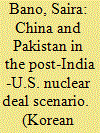

|
|
|
|
|
| Summary/Abstract |
Nuclear relations in South Asia cannot be fully analyzed without taking into account the China factor. After the May 1998 nuclear tests, a substantive amount of strategic literature has been focused on Indian and Pakistani nuclear postures and policies, respectively. However, their integral links with China in transforming South Asia’s nuclear environment remains one critical component that has not
been adequately examined. Multifaceted cooperation, competition and conflict have engulfed this triangle since the India-U.S. nuclear deal. This deal has significantly increased India’s nuclear weapons capability, and hence exacerbated the security dilemma of Pakistan and China, which has important implications for the strategic stability in the region. This paper analyses the strategic implications of this deal for the nuclear triangle and argues that the nuclear triangle will remain complex with inherent risks as well as pose challenges to the region’s strategic stability. China-India-Pakistan nuclear strategies will be determined by the larger triangle of U.S.-China-India relations, which will define the politics of South Asia as well as the larger Asian landscape.
|
|
|
|
|
|
|
|
|
|
|
|
|
|
|
|
| 15 |
ID:
150943


|
|
|
| 16 |
ID:
128497


|
|
|
| 17 |
ID:
119389
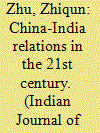

|
|
|
| 18 |
ID:
123576
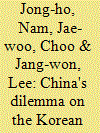

|
|
|
| 19 |
ID:
132868
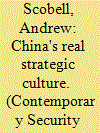

|
|
|
|
|
| Publication |
2014.
|
| Summary/Abstract |
The Great Wall is frequently held up as the most striking symbol of the potency of a persistent Chinese pacifist, non-expansionist, defence-minded strategic stance. But how accurate is this 'Great Wall' depiction of China's strategic culture? What is the impact of this depiction on China and the Asia-Pacific region? While the Great Wall is an apt symbol of a romanticized image of Chinese strategic culture, the reality behind the genesis of this impressive fortification and the accompanying pervasive belief in a monistic strategic tradition is that they are figments of the collective contemporary Chinese imagination. Nevertheless, these formidable myths exert real influence on two 'faces' of strategic culture. The first face refers to how leaders and society perceive the policies and actions of their own country. The second face, routinely neglected, refers to how leaders and society in one state perceive the policies and actions of an adversary or potential adversary state, which, like the first face, is constructed out of myth. The impact of these two faces on the Asia-Pacific region exacerbates the region's security dilemma, adversely impacting China's relations with other countries, notably Japan and the United States.
|
|
|
|
|
|
|
|
|
|
|
|
|
|
|
|
| 20 |
ID:
132420
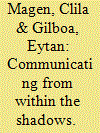

|
|
|
|
|
| Publication |
2014.
|
| Summary/Abstract |
Communicating with the media is an ongoing complicated task intelligence services tackle from the day they are established. The relationship is inherently tense because one side wishes to reveal what the other wishes to conceal, highlighting the constant contradiction between two major principles: the public's right to know versus the government's duty to protect national security. Reconciling these two principles becomes exceedingly complex during crisis situations because both the media and the public demand to know what is happening and why, whereas intelligence services can offer only limited and often incomplete information, a limitation imposed by the need to protect vital secrets. Moreover, the services frequently face a quandary: they are innately secretive and cannot advertise their accomplishments and successes, but these are commonly exposed when they fail. This distorts the natural balance other organizations are generally able to maintain between failures and achievements and any publicity about them.
|
|
|
|
|
|
|
|
|
|
|
|
|
|
|
|
|
|
|
|
|